HIGHLIGHTS
PROGRAM UPDATES
AWC Supports Fire Services With Revamped WoodAware Website AWC Proposals Considered During ICC Group B Hearings Think Wood Media Tracks Trends, Shares Lessons LearnedINDUSTRY NEWS
Data Drives Increased Construction Efficiency New Materials Pledge Reaffirms Building Communities’ Dedication to Sustainability New Timber Tower Set to Rise in Minneapolis MIT Workshop Develops Stunning Longhouse Prototype New Report Asserts Sustainability of Mass Timber The USFS Report Depicts State of U.S. Forests Reviving Vocational Education Key to Reversing Skilled Labor Shortage University of Idaho Chooses Mass Timber for New Arena CLT Aligns with Microsoft’s Push for Sustainability, Carbon NeutralityINSIGHTS ON THE COMPETITION
The High Cost of ConcreteProgram Updates
AWC Supports Fire Services With Revamped WoodAware Website
In May, the American Wood Council (AWC) relaunched its WoodAware website in time to celebrate Building Safety Month. WoodAware provides fire-service professionals with extensive, data-driven resources on fire safety, fire testing, training, and wood products, as well as examples of common wood construction found in residential and commercial structures. The revamped site also includes a new section on mass timber, whose usage is expected to grow significantly thanks to forthcoming code changes that will allow mass timber construction up to 18 stories.
Fire services are an important audience for the wood products industry, and the AWC is committed to outfitting them with the knowledge and information they need to ensure their safety and increase their understanding of the performance and fire safety of wood. The AWC revamped the site based on input from fire-service professionals to help ensure that the information provided meets their needs.
AWC Proposals Considered During ICC Group B Hearings
The 2019 International Code Council (ICC) Group B Committee held action hearings April 28 – May 8 in Albuquerque, N.M., to review and hear testimony on more than 1,300 proposed code changes to ICC 2021 buildings standards, including proposed changes to the administrative and structural provisions of the International Building Code, the entire International Residential Code (IRC), and the International Energy Conservation Code. Final action on committee recommendations will take place in October.
The AWC submitted and advocated for 23 proposed changes on behalf of the softwood lumber industry, including the following:
- Address when and where preservative-treated lumber is required and limit the geographical exception.
- Create consistency with the nailing requirements in the ICC-referenced AWC Wood Frame Construction Manual and the IRC.
- Allow for engineering design in lieu of prescriptive nailing requirements for connecting lumber used as nail-laminated decking.
- Ensure that connections are being properly engineered and detailed to account for lumber shrinkage that may occur after fabrication.
- Clarify that building officials must accept inspection reports from third-party agencies for prefabricated assemblies; this is an issue a new Board Task Group will consider along with inspecting prefabricated building parts that are not visible on job sites.
- Recognize the AWC’s 2021 Special Design Provisions for Wind and Seismic and Permanent Wood Foundation Design Specification, respectively.
Think Wood Media Tracks Trends, Shares Lessons Learned
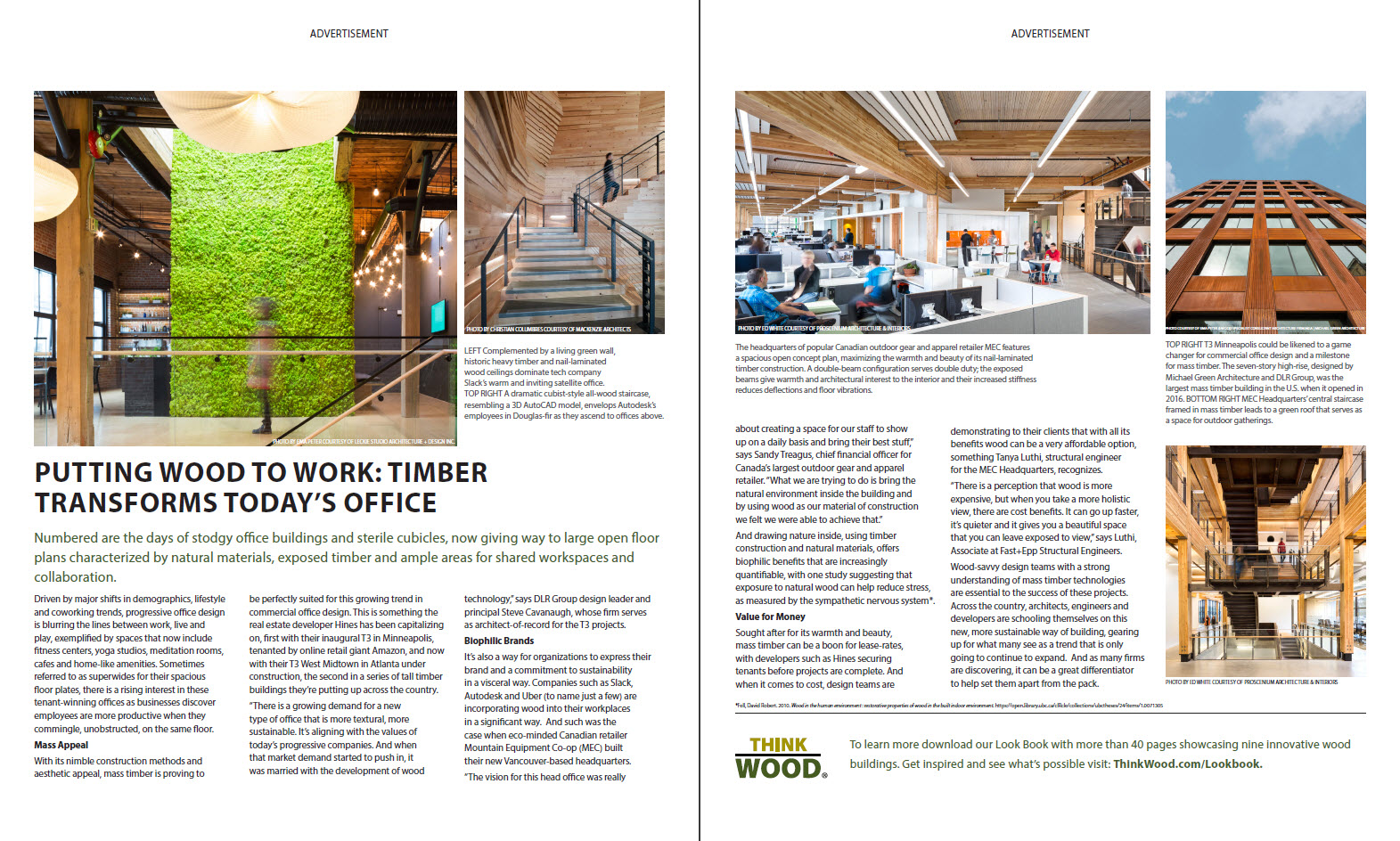
Think Wood uses a mix of paid and earned media to increase pro-wood coverage and ensure consistent, positive mentions of wood in the publications most used and respected by architects and developers. These include key industry and trade publications such as Architect, MultiFamily Executive, Architectural Record, Building Design & Construction, and ArchDaily. Think Wood pays particular attention to covering trending topics and offering lessons learned, appreciating the value that architects and developers place on this type of content.
Recent examples of Think Wood’s earned and placed media:
- Development: “Prefabricated Wood Construction Shows Promise”
- ArchDaily: “Mass Timber: Shattering the Myth of Code Exceptions”
- Architect: “Putting Wood to Work; Timber Transforms Today’s Office”
- Building Design & Construction: “Natural Wood Plays Wellness-Focused Role in National Veterans Resource Center”
Industry News
Data Drives Increased Construction Efficiency

Recent analysis highlighted how technology can help make construction more efficient and lead to cost savings. According to McKinsey Global Institute, the construction sector is currently the world’s second least digitized industry, behind agriculture. The failure to use data and analytics creates numerous inefficiencies, resulting in construction waste, cost overruns, and schedule delays.
Data advocates argue that data capture in the construction sector is more feasible than ever, thanks to a growing array of mobile-enabled solutions, GPS, and drones. Meanwhile, the effective analysis of data captured can result in a better understanding of costs and timelines, leading to more precise budgeting, more effective time and project management, and more accurate calculations of margins.
Learn more about improving data usage here.
New Materials Pledge Reaffirms Building Communities’ Dedication to Sustainability
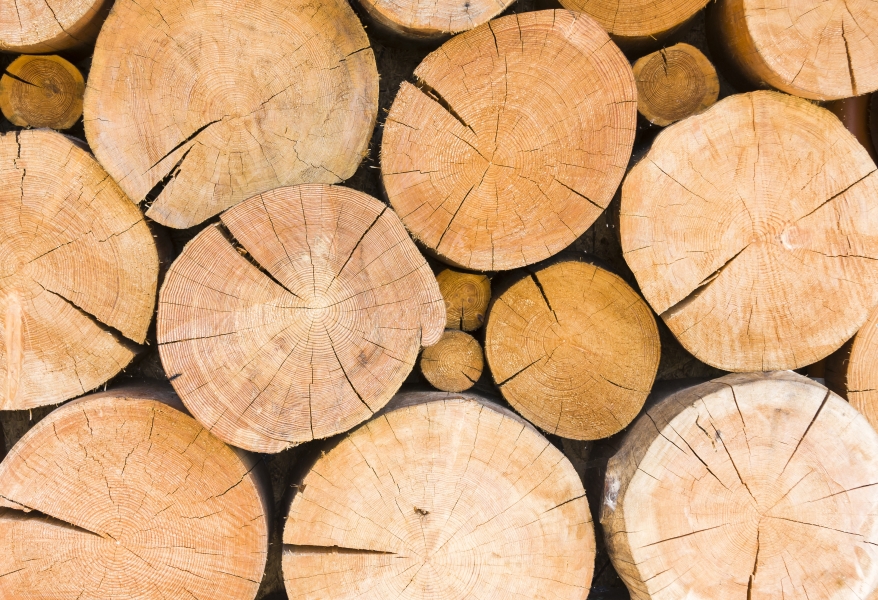
Buildings contain thousands of components, many with different individual chemical compositions and characteristics. To meet the sustainability goals set out for their projects, construction professionals need access to transparent, accurate information about the products they are considering when specifying materials.
To incentivize greater transparency regarding product information, ZGF, an award-winning architecture and interior design firm, has teamed with 56 industry peers to launch the Materials Pledge. The Pledge is an open letter to the manufacturing community, signed by architecture, engineering, and design firms, declaring their intent to design and build with the best materials available that help them positively affect human health and the environment.
Read more about the Materials Pledge here.
New Timber Tower Set to Rise in Minneapolis
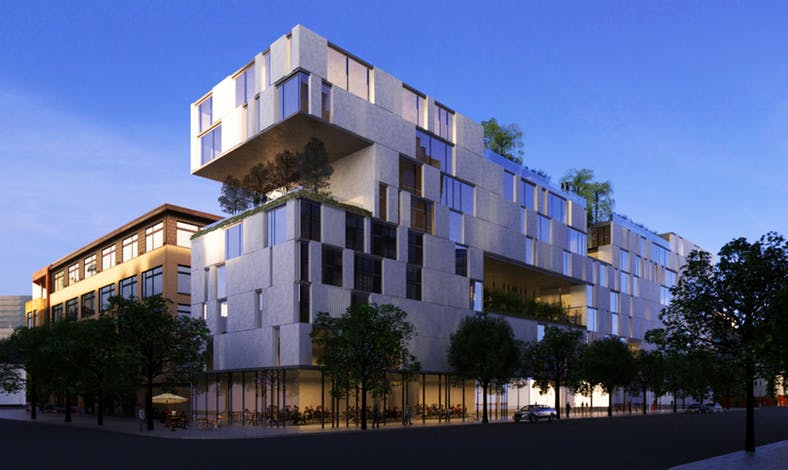
D/O Architects in Minneapolis recently designed a pair of cutting-edge condominium buildings focused on the use of innovative building materials. Among these is TMBR, a 10-story building the company hopes to build in the North Loop neighborhood in partnership with lead developer Kroiss Development. If the building comes to fruition, it will be the tallest all-timber residential building in the Midwest.
Kroiss was inspired to build with wood after touring the nearby all-timber office building T3. In TMBR, D/O plans to use sustainably grown laminated wood beams that will be fabricated in a factory and assembled on-site using metal joinery.
TMBR originally exceeded local codes’ height limit for wood buildings but has since gained approval from local building officials and city planning staff thanks to precedence created by the recently approved ICC 2021 standards allowing for taller wood buildings.
Read more here.
MIT Workshop Develops Stunning Longhouse Prototype
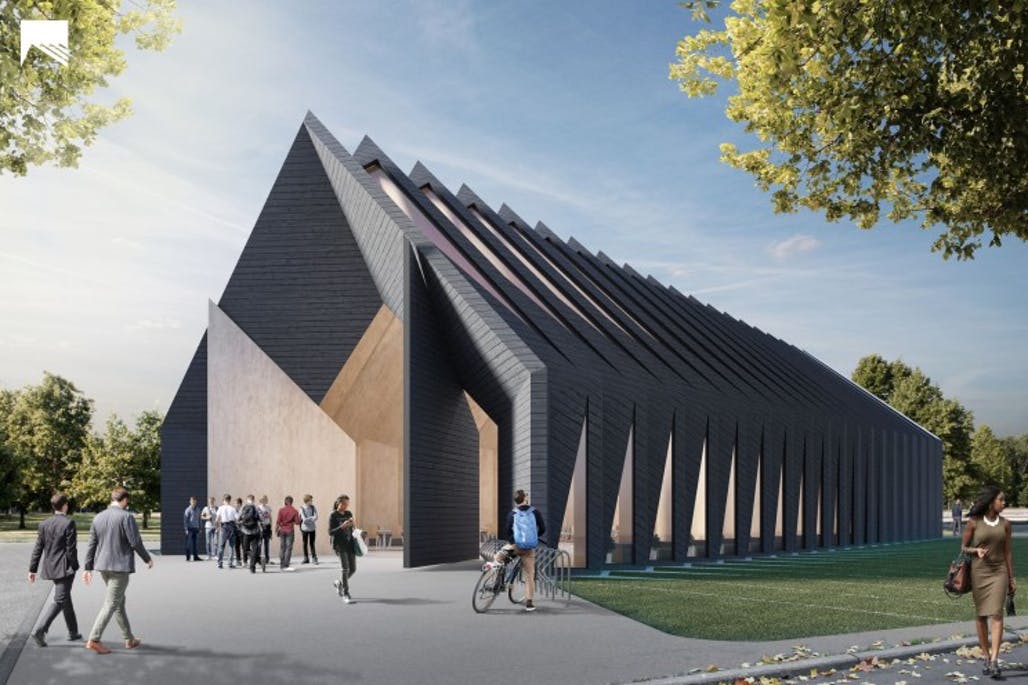
Mass Timber Design, MIT’s architecture workshop focused on technology and sustainable building design, has developed a mass timber longhouse prototype. Longhouses were communal dwellings commonly found in Iroquois and other native communities in North America. MIT’s longhouse draws on this history, aiming to serve as a multifunctional building offering shared communal space. The building features a series of beautiful timber-laminated veneer lumber arches.
View images of MIT’s longhouse prototype here.
New Report Asserts Sustainability of Mass Timber
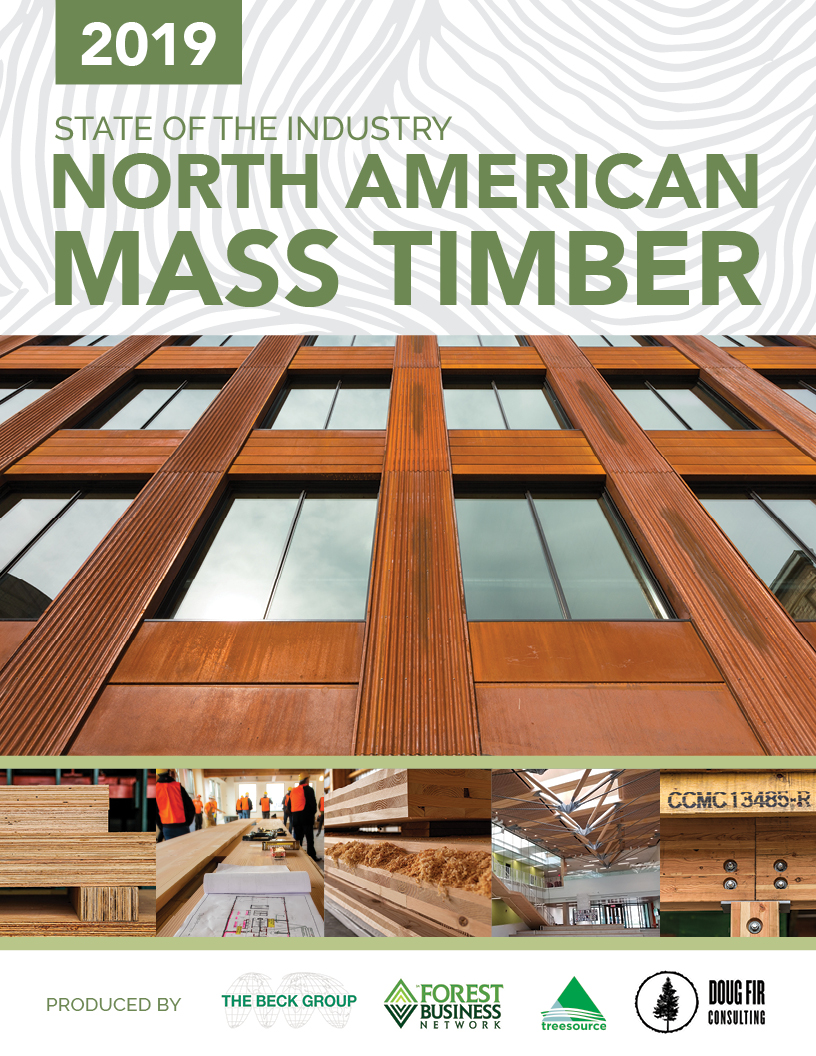
The Forest Business Network and partnering firms recently released the North American Mass Timber State of the Industry report for 2019, which examines the current state of the mass timber industry and its prospects for the future. A key finding of the report is that increased demand for forest products and lumber arising from the development of mass timber can be met without overharvesting and, therefore, will not lead to deforestation in the U.S. or Canada. Already the quantity of forestland in North America has been stable for decades, and since the 1970s, the U.S. has grown more timber than it loses to harvesting and natural mortality.
Coupled with mass timber’s carbon benefits—both its ability to store carbon and its lower emissions during manufacturing—wood earns its reputation as an optimal material for the construction industry thanks to its renewable, biodegradable, and sustainable nature.
The full report is available for purchase here.
The USFS Report Depicts State of U.S. Forests
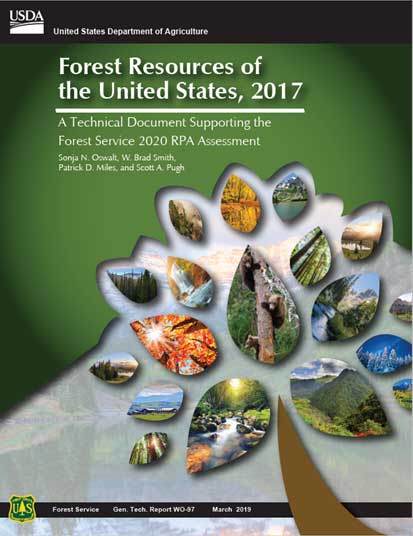
In March, the U.S. Forest Service released Forest Resources of the United States, 2017, which provides exhaustive statistics on the current state and usage of U.S. forest resources, including current and comparative estimates of forest area, volume, mortality, growth, removals, and timber-product output. These statistics combine to provide important insights into U.S. forests’ overall health and productivity.
The report, which is available for download here, will serve as a key resource in support of the upcoming 2020 Resources Planning Act Assessment.
Reviving Vocational Education Key to Reversing Skilled Labor Shortage
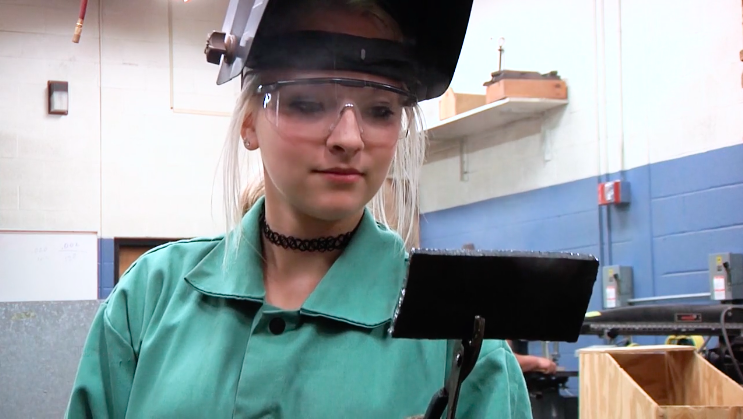
PBS’s respected NewsHour program recently examined the skilled labor shortage in the U.S. and what some states are doing to reverse the trend. The labor shortage is widely regarded as the unfortunate consequence of the nation’s decades-long push for high school graduates to pursue academic degrees rather than attend vocational schools or trade programs. This in turn eroded the image of vocational education and trades jobs, despite their stability and good wages.
According to the Georgetown Center, the U.S. has roughly 30 million jobs that pay an average of $55,000 per year and do not require a bachelor’s degree. Meanwhile, the U.S. Department of Education reports that people with technical educations are slightly more likely to be employed than those with academic credentials and significantly more likely to be working in their fields of study.
California, for example, is working to reverse technical school’s image problem as a means to reverse the labor shortage trend. The state is scheduled to spend $6 million to market vocational education and $200 million to improve its delivery.
Read NewsHour’s story here.
University of Idaho Chooses Mass Timber for New Arena
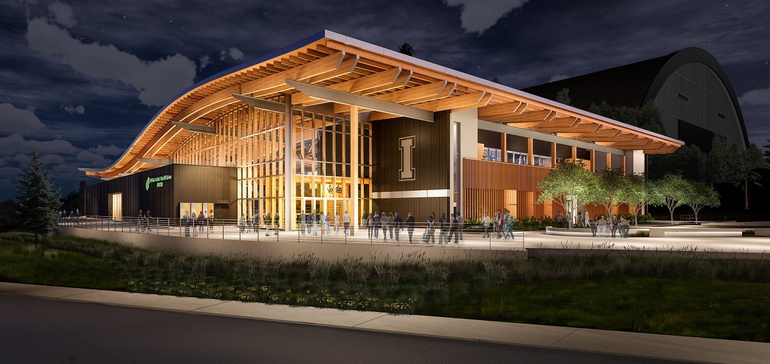
The University of Idaho is the latest college campus to choose mass timber construction as a way to reiterate the university’s commitment to sustainability and innovation. It also gives a nod to the state’s timber industry. The university’s proposed 4,200-seat Idaho Central Credit Union Arena will feature mass timber as a primary structural material and will become the second and largest mass timber building on campus.
According to SLB research, 34 mass timber buildings have been completed or planned on U.S. college campuses nationwide. The U.S. Forest Service, in partnership with the U.S. Endowment for Forestry and Communities, is working to incentivize even greater adoption of mass timber on college campuses via the recent launch of the Mass Timber University Grant Program, which will give up to $1 million to help colleges build with mass timber.
Read more here.
CLT Aligns with Microsoft’s Push for Sustainability, Carbon Neutrality
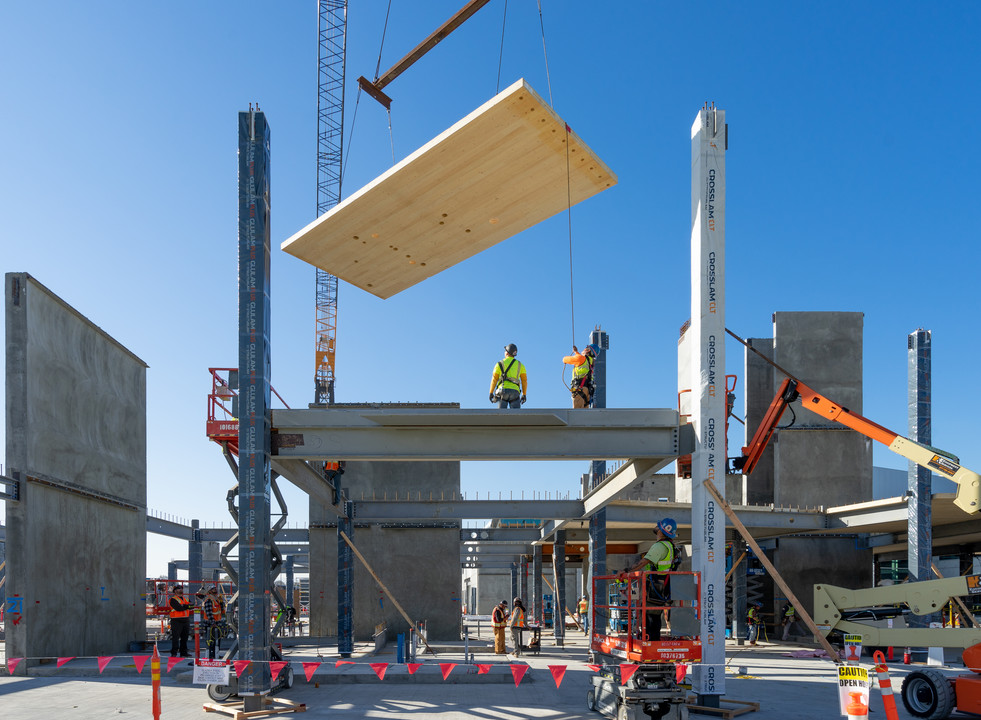
Back in February, we reported on a major technology firm choosing cross laminated timber (CLT) as the primary structural material for its redesigned corporate campus. That firm is Microsoft, and construction is moving full steam ahead. The project is on target to consume 345,000-square-feet, or 2,400 tons, of CLT, which, once completed, will make it the largest wood structure in the U.S. by volume of wood used.
Specifying CLT was only one of many decisions Microsoft has made in order to meet its ambitious sustainability goals. In addition, the project will restore habitat surrounding the campus, store thermal energy, use data to optimize power usage, and source 100% of the campus’s nondrinking water from a combination of rainfall and on-site water recycling.
Read more about the project here.
Insights on the Competition
The High Cost of Concrete

New commentary in Engineering magazine reminds us that “there’s nothing green about concrete.” The author delves into how concrete is made in such a way that it generates up to 8% of global carbon dioxide emissions, points out that the concrete industry could reduce its carbon footprint and water usage through modified production practices, and highlights potential alternatives to concrete. CLT rises to the top of the list of potential alternatives to concrete in building construction thanks to its comparable strength and notable absence of environmental drawbacks compared with concrete.
Industry Resources
Virginia Tech’s Monthly Housing Report
This monthly housing commentary report is a free service of Virginia Tech and is intended to help one gauge future business activity in the U.S. housing market.
March 2019 Reports (released in May 2019)
Part A: March Housing Commentary
Part B: March Economic Conditions
A Closer Look – New Infographic Shows the SLB’s 2018 Impact
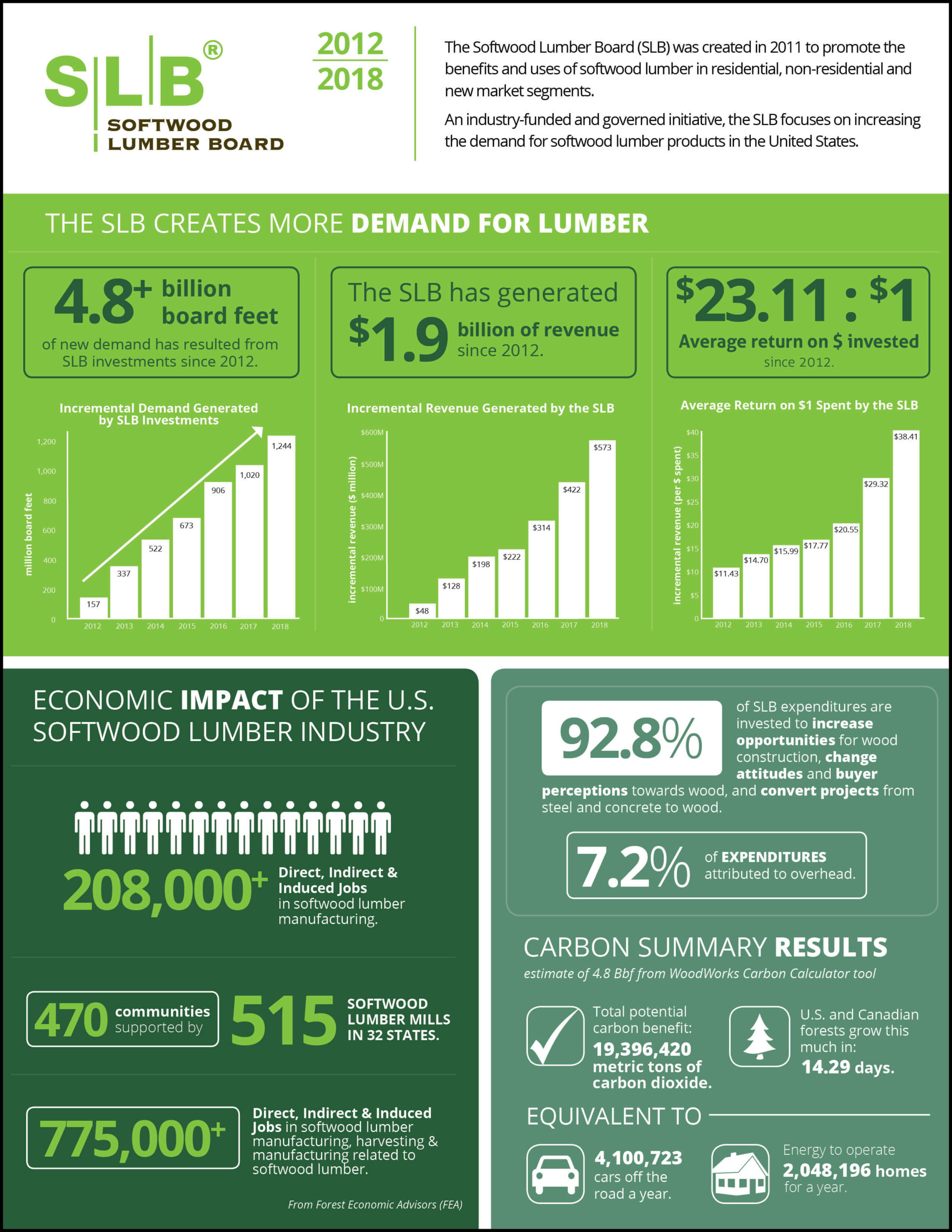
As it has done in years past, the SLB summarized its annual results from 2018 in a succinct infographic that allows investors, industry stakeholders, and program partners alike to quickly absorb the depth and breadth of the SLB’s yearly impact and its significance for the softwood lumber industry. Among its headlining results, the SLB’s programs created over 1.2 billion board feet of demand in 2018—our best annual output to date and an 18% increase from 2017—and the SLB’s cumulative return on investment rose to $23.11 of revenue generated for every $1 invested since 2012.
View the infographic here, and please consider sharing it with your colleagues and associates in the softwood lumber industry and beyond.
West Fraser featured on TV’s Tomorrow’s World Today
Emmy-nominated TV show Tomorrow’s World Today recently turned its attention to the remarkable innovations taking place in sustainable lumber manufacturing. In its recently aired “Growing Power With Tree Sustainability” episode, the show visited with North American wood products company West Fraser to learn how the company is maximizing the value of every log harvested to supply high-performance wood products to the construction industry as well as create new forms of energy. The episode also highlights how trees are replanted to replenish what is harvested, ensuring the continuation of a fully renewable, natural resource business.
Tomorrow’s World Today airs weekly on the Science Channel. To view the episode online, click here.

